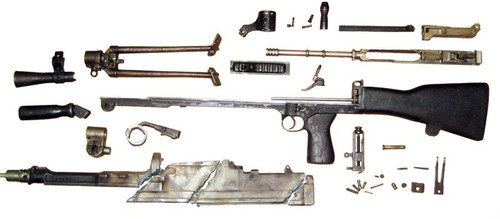An Intro to the Bren LMG
Jun 25th 2025
The Bren gun, or Brno-Enfield, designed in Czechoslovakia and built in the United Kingdom, was introduced in the 1930s and is best known for its service in the hands of Commonwealth forces during World War II, but it actually had a much longer service history that took it through the Korean War and into the 21st century.
This short post will offer a little background on this LMG.
What’s the Deal with the Name?
The Bren gun is so named because of its origins in Brno, Czechoslovakia, the city in which it was designed, before those designs were sent to the Royal Small Arms Factor in Enfield where the eventual platform was developed and built.
The Origins (and Service) of the Bren Light Machine Gun
By the end of the First World War, the British Commonwealth forces were equipped primarily with two automatic platforms: the Lewis Gun, a light machine gun that fed from a helical magazine, and the Vickers MMG, a medium machine gun, both of which were predominantly chambered in .303 British.
Both of these guns were plagued by issues; the Vickers was heavy and had a water-cooled barrel, which meant that it was effectively resigned to stationary roles. As for the Lewis, though it was lighter and had an air-cooled barrel accelerated by an advanced aluminum-finned heat sink system, it was still heavy and the barrel could not be changed in the field.
The British needed something lighter and more mobile, but which offered comparable firepower and a high rate of fire as well. They set to conduct a series of trials between several extant machine gun platforms, including but not limited to the Lewis gun, the M1918 BAR, the Hotchkiss M1909, and a Czechoslovakian light machine gun known as the ZB vz. 27. It was also chambered in 7.92 Mauser rather than in .303 British.
The latter, which was gas-operated, did not meet the standards for which the British hoped, mainly because cordite fouling obstructed the gas tube and hindered reliability. However, a variant, the ZB-30, which was chambered in .303 and redesigned with a shorter gas tube, performed better in follow-up testing.
Changes were made to the magazine and barrel (as well as the aforementioned gas tube) along with the pistol grip; it was changed from a swiveling pistol grip to a sliding pistol grip.
This new “Bren” machine gun was also notable in that it had an adjustable gas system which enabled the operator to tune the rifle according to changes in ambient air temperature, allowing more gas for use in colder temperatures, or less gas when temperatures were colder.
Notably, the gun also had a design that enabled the operator to quickly and relatively easily change the barrel in the field, which rectified shortcomings of both the Lewis and Vickers machine gun platforms.
It is also notable that the design of the Bren LMG was also downward-ejecting, an improvement over platforms like the Lewis gun, which was side-ejecting. The downward-ejecting design helped prevent hostile eyes from spotting the gun’s location, keeping the operator concealed.
Another advantage of the Bren’s design is that, being magazine fed, the ammunition was enclosed, unlike in the case of belt-fed guns, keeping it cleaner and therefore ensuring smoother and more reliably feeding.
On the flipside, being magazine fed, the gun had a slower rate of fire and required more frequent magazine swaps - but considering the lighter weight, less than 23 pounds in the case of the Mk. 1 (compared to nearly 30 pounds in the case of the Lewis gun) this concession was well worth it.
Though it was light by the standards of other LMG platforms, the Bren was commonly fired from a bipod; however, it could also be partially supported by a sling and fired somewhat comfortably from the hip, in the “marching fire” configuration.
All in all, the Bren was generally well-liked by the soldiers that carried it, and was considered very reliable and unlikely to jam - tolerant as well of “maltreatment and unskilled use,” which is quite a lot to ask of an autoloading platform.
While it was widely used by the British Expeditionary Force along with other Commonwealth forces in World War II, it was also used in Korea, the Malayan Emergency, the Conflict in Northern Ireland, and as recently as the Falklands War and First Gulf War. After the British adopted NATO standards, subsequent iterations of the Bren LMG were reconfigured to accept the 7.62 NATO cartridge rather than the .303 British.

Here for a Bren Parts Kit?
Looking for a Bren parts kit or for other Bren parts? We carry parts kits with demilled receivers as well as various other Bren parts, including but not limited to bipods, grips, springs, and a whole bunch of other parts. Shop our parts kits and get in touch with us if you have any questions about parts compatibility or replacement.

